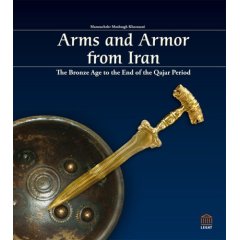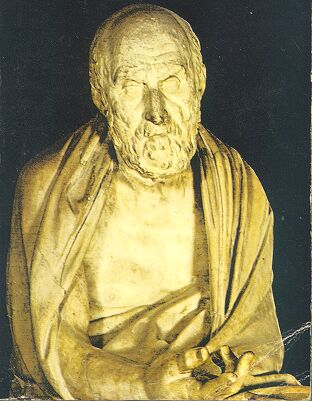There are very few historians who doubt the tenacity and military skill of the Greek defenders who faced the invading army of Xerxes. The 300 movie displayed the equipment of the Spartans relatively well, considering that the producers were intent on reproducing the images of a comic book, leaving little room for consultation with modern scholarship. If the portrayal of the Greek side was adequate, that of “the Persians” was pure fantasy. This being said, there are already a large number of viewers who have taken these images in a very “literal” and historical context … the human mind is indeed a very impressionable organ.
The discussion here is a very quick and overall analysis of the actual military factors that were in place during Xerxes’ invasion of Greece in 480 BC – however we will digress into the post-Alexandrian eras, notably the evolution of the Persian knights during the Parthian (238 BC- 224 AD) and Sassanian (224-651 AD) eras. I will closely scrutinize the veracity of whether Xerxes actually wielded 1,700,000 troops during his invasion of Greece. By no means is this discussion adequate, however it is hoped that the reader’s curiosity will be sufficiently evoked as to encourage further research and readings.
Weapons
Greek spears and swords were longer than their Achaemenid counterparts. This meant that in hand to hand combat, the Spartans held the advantage and were able to “outrange” their opponents with their swords and spears, which were primarily used for thrusting (see Farrokh, Shadows in the Desert, 2007, Chapters 4-5). The swords of “the Persians” in the movie are of no historical relevance – many of the Iranian swords of that era were short and dagger-like. These were known as the “Akenakes”.
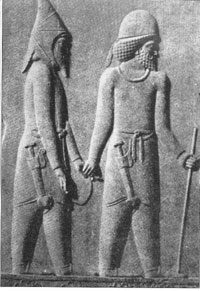
Scythian (left) and Mede (right)
Saka Tigrakhauda (Tall-capped Scythian to the left) and a Mede (round cap to the right) appearing before the Achaemenid kings at the Imperial palace of Persepolis. Note the short size of the Akenakes daggers, which proved inadequate in hand to hand combat against Greek warriors.
For a thorough examination of the Akenakes daggers, as well as all Iranian military gear from the Bronze Age to the 19th century, consult Manoucher Moshtagh Khorasani’s comprehensive book on the subject:
Arms and Armor from Iran: The Bronze Age to end of the Qajar Period
Armor
Greek troops were far better armored than their opponents, although it is not clear if all the Spartans wore heavy armor at Thermopylae. Greek helmets, body armor and greaves provided excellent protection against blade weapons in hand to hand combat, whereas the vast majority of the Achaemenids lacked significant armor protection. Scale armor was available, but not to the majority of troops. When engaged in hand to hand combat, Achaemenid troops were exposed to deadly spear thrusts as well as hacking/thrusts against their faces, limbs and torso (see Farrokh, Shadows in the Desert, 2007, Chapters 4-5). The movie portrayal of Achaemenid armor, was pure fiction and has no resemblance to that issued among Achaemenid troops.
The Martial Arts Tradition of Greece
The 300 movie did capture the camaraderie, zeal and “esprit de corps” of the Spartans very well, and represented the contemporary military culture of ancient Sparta in a fairly realistic manner.
Greece (as a whole) was the heir to an excellent martial arts tradition. According to legend, the newborn child in Sparta would be washed by his mother in wine to ensure that the child was strong and fit (the weaker baby would reputedly die from the bathing). The father would then bring the baby to advisors who would ultimately decide if the newborn child was fit to be raised as a Spartan. If the baby “failed” the test, he would cast off a cliff or gulley at Mount Taygetos, known as the “Kaiada“.
As shown in the movie, the boys of Sparta began training from the age of 7. Formal military service would begin at the age of twenty. Examination of Greek vases clearly shows Greek warriors engaged in very “modern” training methods: kicking, boxing, wrestling, Pankration, using “speedbags”, etc.
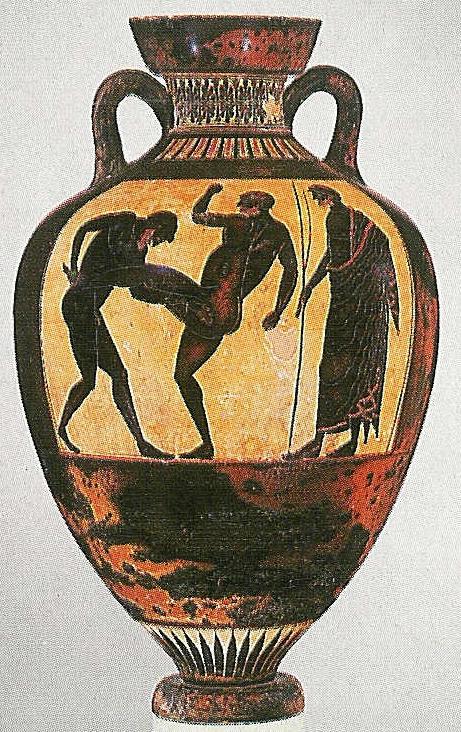
Greek warriors engaged in martial arts “kick boxing” training
Note “coach” to the right.
Training and drills were at least as brutal as combat situations. Sparta was very much a warrior society; it was the Athenians and their ethnic cousins in Ionia (modern western Turkey), then under Persian rule, who were at the forefront of the Hellenic Democratic tradition.
The Greek Phalanx System
The Greeks in general had developed the phalanx system, where soldiers fought as one unit in a single formation. Central to this system was the use of overlapping shields which formed an impenetrable barrier against javelins, spears and arrows. The Macedonians of northern Greece, perfected the phalanx and adopted the 12 foot long pike or “sarissa” used with devastating effect by Alexander the Great during his invasion of Persia.
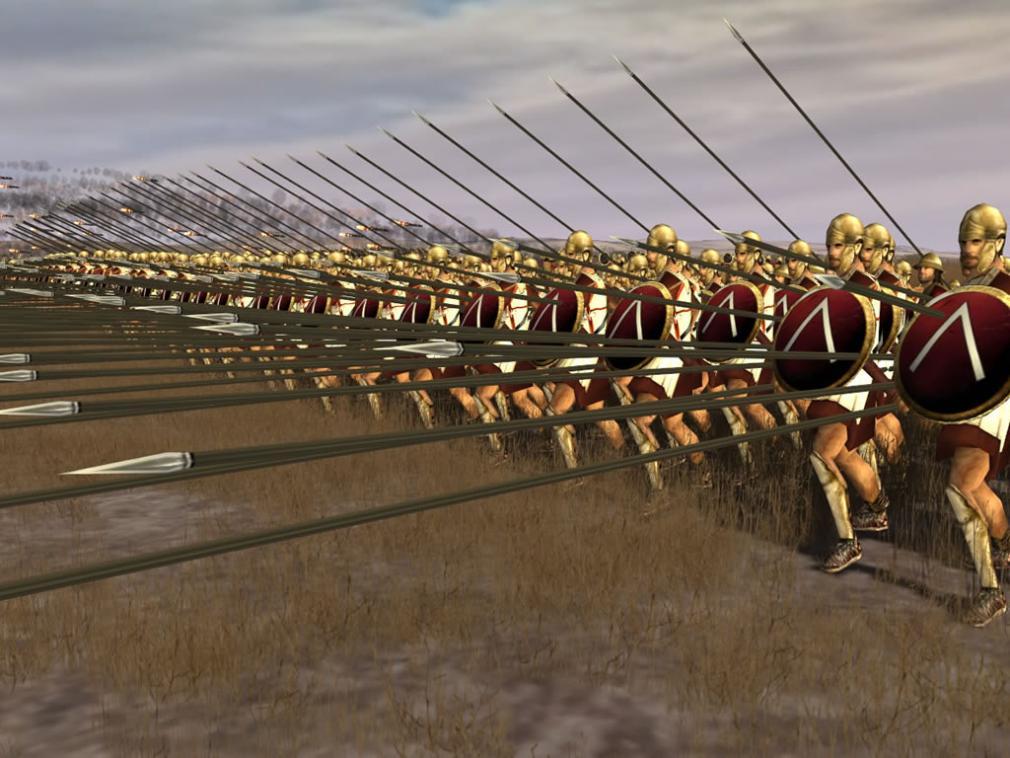
Recreation of a Spartan Phalanx
(Source: www.vedainformatics.com)
The Greeks often engaged in close quarter combat and had been doing so for centuries before the Achaemenid invasions. Suffice it to say that when it came to hand to hand combat, the Spartans held the advantage. Thanks to their training, the Spartans were os disciplined that they were able to collectively maneuver the phalanx at a single command. With their shields locked together, the phalanx was able to march and put forward all of their spears simultaneously. There was no breaking of formation in acts of battlefield individualism – all warriors were expected to adhere strictly and steadfastly to the phalanx. The spears protruded in deadly fashion towards the onrushing enemy, with deadly results. The Greeks testify to the bravery of the lightly armored Iranians who tried to break the spears of the Spartans with their bare hands in an endeavor to get close to the warriors within the phalanx.
The Evolution of cavalry
The portrayal of “Persian cavalry” was totally wrong in the movie with respect to weapons, equestrian gear and uniforms. Superficially, these resembled more the Arab horsemen seen during the Arabo-Islamic conquests over a thousand years after the Battle of Thermopylae and bore little resemblance to either the Iranian cavalry of the Achaemenid era (559-333 BC), or the armored knights of the later Parthian and Sassanian eras of Persia (238 BC – 651 AD). Below is a reconstruction of Iranian heavy cavalry of the Achaemenid period.
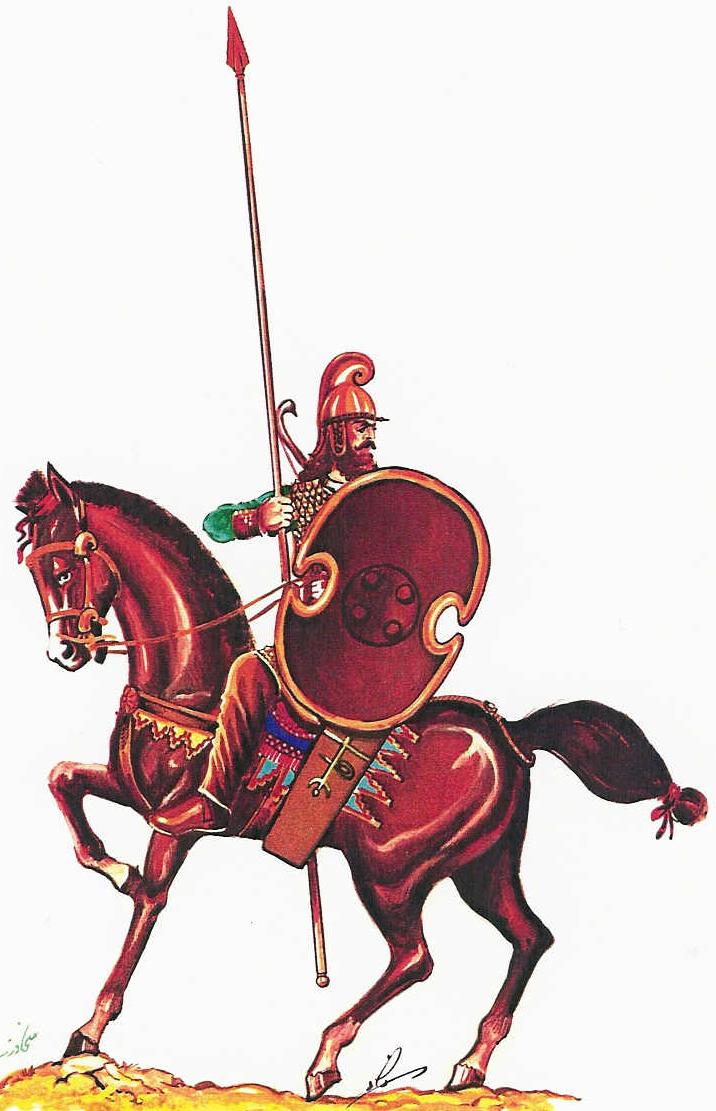
Mede Cavalryman of the later Achaemenid era
Despite their formidable armor, Achaemenid cavalry had yet to solve the problem of rider stability, especially against well-trained, heavily armored, lance/spear wielding infantry fighting in phalanxes (see Farrokh, Shadows in the Desert, 2007, Chapters 4-5). This is mainly because the Iranians had not yet invented saddle technology advanced enough to keep the rider stable enough as he fought on horseback. As a result, Iranian cavalry during the Achaemenid period was vulnerable to unseating by Greek heavy infantry, a fact that was duly observed by Xenophon in the early 400s BC.
Nevertheless, Iranian cavalry continued to evolve, even after the Alexandrian conquests of the Persian Empire. It was the cavalry which had posed the greatest challenge to the Greeks during their conquests of Persia, and the Greeks were duly impressed by them. Xenophon warned about the dangers of the Iranian cavalry, a prophecy which was to prove true with the rise of the Parthians and the Sassanians. It was these new Persian knights who finally defeated the Seleucid successors of Alexander and who scored dramatic victories against Marcus Lucinius Crassus at Carrhae (53 BC), and against Roman Emperors Severus Alexander (Ctesiphon in 233 AD), Gordian III (Mesiche in 244 AD), Phillip the Arab (Barbalissos in 253 AD), Valerian (Carrhae-Edessa in 260 AD), and Julian (inside Persia in 363 AD). By the 5th century AD, the Turks had arrived from the North of China into Central Asia and Europe, and were influencing the Iranians and the Romans: the Turks were probably the first to invent stirrups.
Very few are aware of the positive references to the military skill of the later Persian knights. One example is Libianus who, referring to the Sassanian knights, notes that Roman troops “prefer to suffer any fate rather than look a Persian in the face”
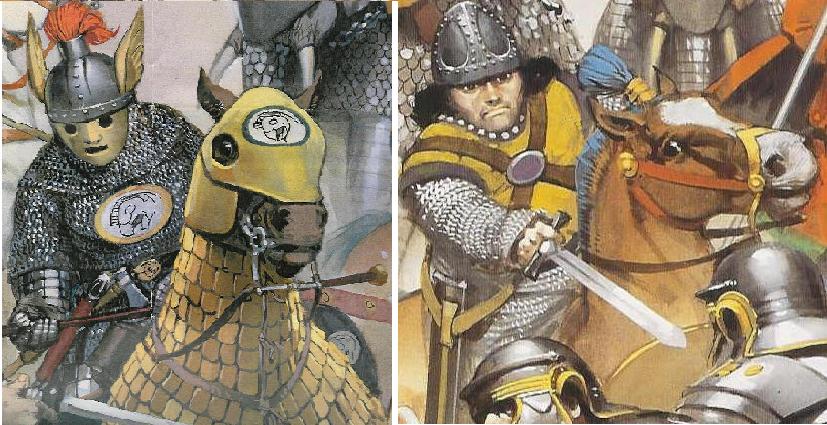
The Pushtighban Heavy Knights of the Royal Guard (left) and Jyanavspar-Peshmerga (right) engaged against Roman troops during the failed invasion of Emperor Julian in 363 AD (Farrokh, Elite Sassanian Cavalry-اسواران ساسانی-, 2005, Plate D; Paintings by Angus McBride).
Much of the armor of these knights appears very “European”; the warriors wear mail, plate armor, riveted Spangenhelm helmets, broadswords, maces and battle-axes. Yet these warriors predate their European counterparts by centuries (see Farrokh, Sassanian Elite Cavalry, 2005).
Though the Spartans (and indeed the Greeks as a whole) are rightfully remembered as magnificent warriors whose exploits and heroism resonate across time, Persia too gave birth to magnificent military tradition: the Partho-Sassanian elite cavalry, known as the “Savaran.” Is it not interesting that nobody has even heard of the Savaran? As noted by Greek-Canadian historian, George Tsonis: “Unfortunately we probably will never see movies of Roman defeats in “the east” at the hands of Persian knights … such movies would most probably bomb at the box office.”
This bias is not confined to the entertainment media. The academic community (mainly in northwest European and English-speaking world) has until recently continued to champion ancient Greece and diminish, sideline and even ignore the Savaran. This bias can be seen in the comments of world renowned military historian, Professor John Keegan, who in reference to the Persian influence on western European cavalry states in no uncertain terms that:
True, the Persians … had fielded squadrons of armored horsemen and even armored horses at an earlier date [than the western Europeans] …to ascribe the origin of heavy cavalry warfare to them is risky.” [Richard Keegan, A History of Warfare, 1993, p.286]
Keegan’s interpretation is essentially rejected by a large number of historians such as Herrmann, Michalak, Inostrancev, Nickel and Newark (see discussion by Farrokh, Shadows in the Desert, 2007, Chapters 9-22, 24). Professor Keegan represents a more selective interpretation of the history of cavalry, one that has sought to diminish the role of Persia in particular. As noted by another Greek colleague, “Stamatis”:
… there is no need for academics to denigrate Persia just to preserve the glory of ancient Greece. Both Greece and Persia are glorious in their contributions to world civilization.
Comments such as these are more a product of academic dogma rather than true scholarship. One sees such scholarship in ancient Greece, Persia, Egypt, China and the golden age of Islamic learning where non-Arabs such as the Iranians made mighty contributions
The Immortal Units
Perhaps most interesting was the portrayal of the Immortal units of the Achaemenids. Superficially, they resembled Hollywood-style “ninjas”, dressed in black. Black and dark clothing were not featured among any of the standard Achaemenid troops. The superficially “Oriental” looking iron face masks were never used by the elite troops, and as noted above, Iranian units (in general) were more lightly armed and armored than their Greek counterparts. The paintings below provide a more accurate reconstruction of the uniforms, weapons and armor of the Achaemenid troops.
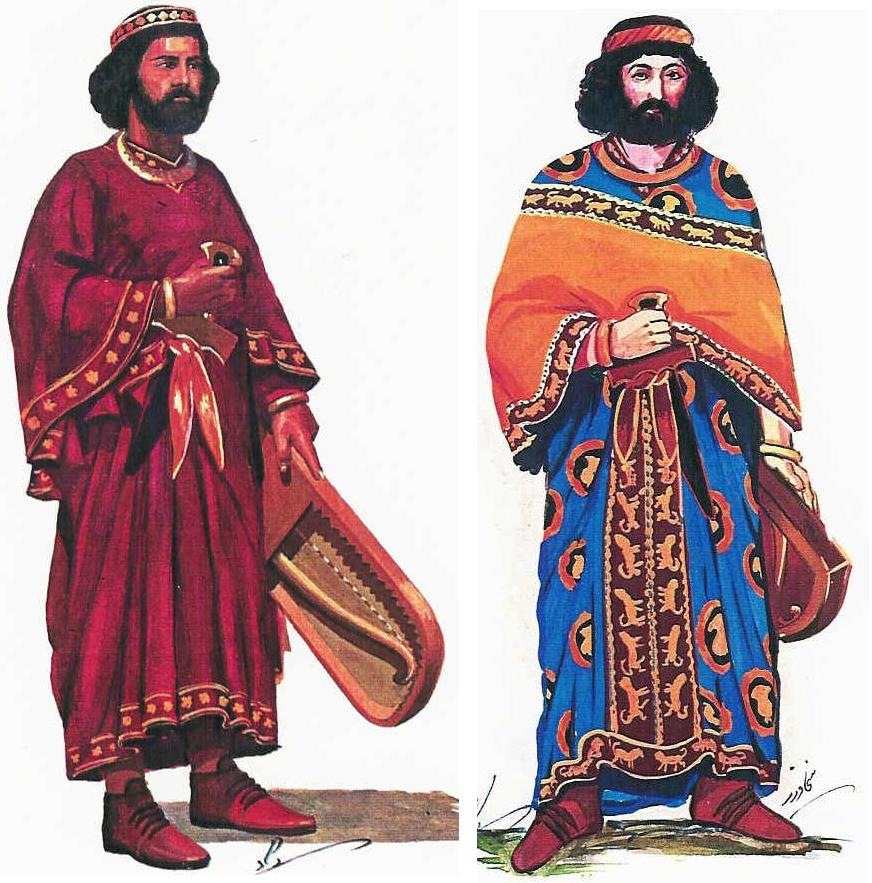
Achemenid Persian officers as they would have appeared during Xerxes’ invasion of Greece.
These were reconstructed by historians, researchers as well as professional army officers in 1971. Suffice it so say, that the movie portrayal and historical veracity are widely divergent. Note the colors on the uniforms as well as the equipment (and virtually no armor). But at least the creators of the 300 picture admit that they are basing their “Persians” on cartoon-like demon characters.
The Size of Xerxes’ Invasion Force.
Few question the fact that Xerxes’ army was huge and that the Greeks were outnumbered. The question is “by how much”? The trailer of the movie states:
“They [the Spartans] were 300 men against a Million“.
The main source of these accounts for modern European scholarship is Herodotus, who actually cites 1,700,000 invaders (Herodotus, VII, 60). Herodotus, who wrote after the Greco-Persian wars of Darius and Xerxes had ended, and before the age of Alexander.
Herodotus lists a total of 46 nations mustered by Xerxes in his invasion of Greece (see Farrokh,Shadows in the Desert, 2007, Chapter 5). The vast numbers of troops were actually a liability as co-ordination and communication and logistical support must have been complex, particularly in contrast to the much smaller and compact, and linguistically uniform, Greek force.
Nevertheless, it is unfair to pin these quantitative citations solely on Herodotus. The Greek tragedy by Aeschylos, The Persians, describes the Greeks facing Xerxes’ armies as facing “a great flood of humans…a wave of the sea that cannot be contained by the most solid dikes (The Persians, lines 87-90)…” and “…a rash ruler of populous Asia [Xerxes] pushes a human herd to the conquest of the entire world” (The Persians, 73-75).
It was from the mid-19th to the early 20th centuries when a number of European scholars began to question the fantastic numbers cited by Herodotus. European researchers such as Gobineau and Delbrueck began to seriously doubt the numerical claims made by Classical sources. The table below cites some of the researchers of the period who provided the following estimates as to the actual size of Xerxes’ invading armies:
| Scholar | Citation and Year | Estimated number of Xerxes’ Troops |
Eduard Meyer | As cited in William Kelly Prentice, “Thermopylae and Artemisium“,Transactions and Proceedings of the American Philological Association, Vol. 51, 1920 p. 5-18 | 100,000 plus an equal number of non-combat support personnel |
Ernst Obst | Der Feldzug des Xerxes in Klio, Beiheft 12, Leipzig, 1914, p. 88 | 90,000 |
Comte de Gobineau | Histoire des Perses[History of the Persians],Volume II, 1869 p. 191 | 90,000 |
Reginald Walter Macan | Herodotus, The Seventh, Eighth and Ninth Books,London, 1908, Vol. II, p. 164 | 90,000 |
William Woodthorpe Tarn | “The Fleet of Xerxes”, The Journal of Hellenic Studies, 28, 1908, p. 208 | 60,000 |
Hans Delbrueck | Die Perserkriege und die Burgunderkriege, Berlin, 1887, p. 164 | 55,000 |
Robert von Fischer | “Das Zahlenproblem in Perserkriege 480-479” Klio,N. F., vol. VII, p. 289 | 40,000 |
Most modern scholarship appears to accept the figure of 100,000-200,000 invading troops, a figure consistent with the population base of the Achaemenid Persian Empire at the time (Farrokh, Shadows in the Desert, 2007, Chapter 5). Even if the Persian Empire had had the population base to produce 1,700,000 troops, it would have faced a gargantuan task in organizing and deploying these without the benefit of modern computers and communications technology. Even if such an army could be organized to set off on the mammoth journey from Asia to Greece, ancient logistics and supply would not have been able to sustain such fantastic numbers of troops in so ambitious a campaign. These capabilities date from far more recent modern times, from the time of the American Civil War (1861-1865) and the advent of the railway and telegraph.
At Thermopylae, the Greek numbers were close to 6000, when counting all of the Spartans and Greek kinsmen. Still, even if we take the lowest estimate of 40,000 Achaemenid Persian troops, the Greeks would have been vastly outnumbered, especially during King Leonidas’ last stand.
Few have addressed the engineering feats that Xerxes’ engineers accomplished in building the world’s first true bridge between Asia and Europe. For an introduction of the Engineering feats that led to the invasion of Europe from Asia Minor (modern Turkey), you may wish to consult the History Channel program:
History Channel -مستند آغاز یک امپراطوری – هخامنشیان –
Note that part 4 narrates the engineering aspect of Xerxes’ invasion of Greece.
A Final Note: The Battle of Salamis.
There are other inaccuracies in the movie as well, especially with regards to the Greek perspective. First, the Spartans were not exactly “democratic” in the Athenian sense; theirs was a hierarchical and militaristic society. To argue that the Spartans were “fighting for Democracy” is somewhat simplistic. It is correct however that the Spartans fought for the glory of Greece, which included Democracy. That does not necessarily mean that the Spartans specifically stood for Democracy as the Athenians and Ionians did.
Second, the 300 Spartans were not alone in their last stand – they were accompanied to the death by at least 300 Thessapian Hoplites, who fought shoulder to shoulder beside them. The fact is that Xerxes finally won at Thermopylae and pushed through into Greece. The Battle that actually saved Greece from total conquest occurred at sea: the Battle of Salamis, after the forcing of Thermopylae. Xerxes could not maintain or expand his European land conquests if he could not control the seas. The Greeks under the bold leadership of Admiral Themistocles lured Xerxes’ fleet into a trap in the straits between Salamis itself and Piraeus.
Typical of the drama of Greek politics, Themistocles, the man who had rescued Greece from the jaws of defeat, was later condemned as a traitor to Greece and forced to flee Athens! Even more ironic is the fact that Themistocles was given shelter by Artaxerxes I, the successor of Xerxes I! In my opinion, it would be fascinating to have a historically balanced movie that would portray the lives of Themistocles, Xerxes, Artemesia, and Artaxerxes.
Chapters:
- The Notion of Democracy and Human Rights
- What really led to War
- The Military Conflict: Separating Fact from Fiction
- The Error of Xerxes: The Burning of Athens
- The “West” battling against the “Mysticism” of “the East”
- The Portrayal of Iranians and Greeks
- A Note on the Iranian Women in Antiquity
- “Good” versus “Evil”
- Bibliography

